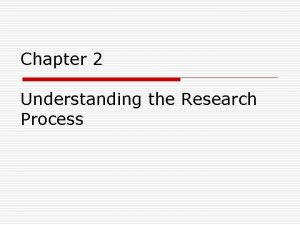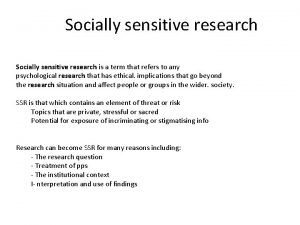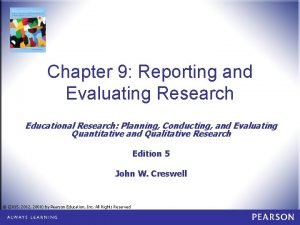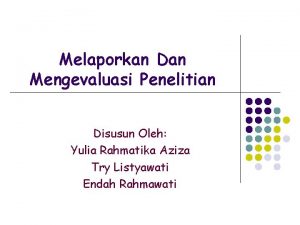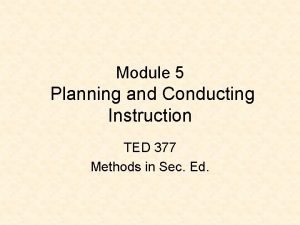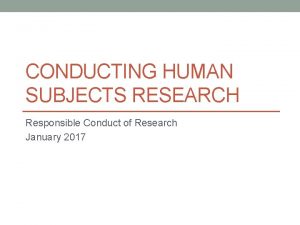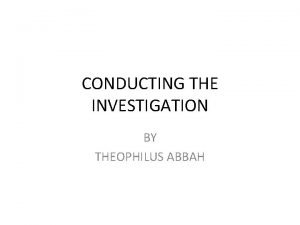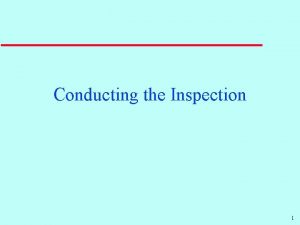Auditing Reporting Slipups When Conducting Human Research Reporting
























- Slides: 24

Auditing & Reporting Slip-ups When Conducting Human Research Reporting Requirements, Submitting RNIs, and Common Audit Findings Alyssa Speier, MS, CIP Associate Director, Office of Regulatory Affairs & Research Compliance & Alma Castro, MA, CIP, Ph. D Candidate Senior IRB Review Specialist

Why report? Regulations!* �DHHS & FDA regulations [*45 CFR 46. 108(4)(i) & 21 CFR 56. 108(b)(1)] require that IRBs have: Written procedures for ensuring prompt reporting of � a) any unanticipated problems, � b) serious continuing noncompliance, or � c) a suspension/termination of the study �DHHS & FDA regulations [*45 CFR 46. 108(3)(iii) & 21 CFR require that IRBs evaluate new information that becomes available during a study which may require the IRB/Investigator to reassess the risk/benefit to participant. 50. 25(b)(5)]

What should be reported? �New or Increased Risk �Adverse Events (Internal & External) �Findings/Allegations of Regulatory Non-Compliance �Audits/Inspections by Federal Agency �Protocol Deviations/Violations �Breach of Confidentiality �Participant Complaints �Protocol Suspension/Termination INVESTIGATOR MANUAL APPENDIX A: PROMPT REPRORTING REQUIREMENTS

When should I report? �Within 5 business days from the time the study team became aware of the information

Where should I report? �All reporting should be done in ESTR via a Reportable New Information (RNI) Submission.

ESTR RNI Submission – Key Elements �Date PI became aware of the information �Category of the new information �Description of the occurrence/incident �If (and why) the incident/new information in the PI’s opinion: Poses a change to the study risk(s) Requires a modification to the approved research �Corrective Action Plan PI is encouraged to propose a plan IRB Review Specialist (and QIP, if engaged) will weigh in Convened IRB, if engaged, will weigh in

Corrective Action Plans �Should include corrective actions and preventative actions �Corrective actions would include: RNI Disclosure Study Audit �Preventive actions would include: Modifications to protocol Modifications to consent Re-consent of participants Re-training of staff

ESTR RNI Submission & Process Ø Once submitted the RNI will first be reviewed by your IRB Review Specialist. Ø You may be asked for further clarification and details about the information you provided in ESTR. Ø The IRB Review Specialist will consider whether the incident is q An unanticipated problem involving risk to subjects or others q Serious noncompliance q Continuing noncompliance Ø If the RNI involves any of the above 3 designations it will be reviewed at an IRB meeting by the full board.

Who should submit report? �Any study team member listed in ESTR can submit an RNI for a study they are affiliated with. If the RNI goes to a convened IRB meeting for review and/or results in an official IRB correspondence letter, this will be addressed to the PI of the study and cc’d to any relevant parties (e. g. Dept. Chair, SPA, Funding Sponsor, Federal Agency, etc). �The IRB can submit an RNI as needed to report on a study

Case Study #1 �A research assistant is traveling for work with their personal laptop which they also use for their research. The RA uses this laptop to access REDCap and conducts their analysis of data on a dedicated HSPH department server specifically for this study. The RA needs to use their Harvard Key to get into the server and their laptop requires a login/password to access. The RA’s bag is stolen at the airport along with their laptop.

Case Study #2 �A participant is in a study that requires them to wear an activity monitor that will collect data on their physical activity, heartrate, and sleeping. The participant starts getting a rash where they are wearing the device and after 4 days wearing the device they decide to take it off and stop with the data collection portion of the study. The participant notifies the study about this at the next study visit which is 2 weeks after they stop wearing the device.

Case Study #3 �A research study collects data from participants via an online survey and no identifiable information is being collected. The online survey is made up of various questionnaires. During the course of the study the research team realizes that they need a new questionnaire to further collect information about participants social media consumption habits so they add in another questionnaire. They collect the new social media consumption habits data from 200 participants before the new questionnaire was approved via a Modification.

Common Audit Findings

Common Audit Findings � Informed consent � Investigator responsibilities � Protocol deviations � Study records � IRB approval � Regulatory documentation

Regulatory Documentation All Studies: l l l l Protocol Staff CVs Training Staff Licensures IRB Documents Logs Consent Forms Data Collection Study-Specific: � Lab Documents � FDA � Investigational Brochure � Drug/Device � NIH � Sponsor � DSMB � Local Review

Participant Files 16 � Maintain participant files securely and separate from the Regulatory Binder according to protocol � Include original signed consent documents � Depending on confidentiality provisions outlined in the Research Protocol, signed consent forms may be kept separate from the participant’s research data � File completed data collection forms and source data � Communication with participants � As above, depending on confidentiality provisions outlined in the Research Protocol, communication that includes identifiers may be kept with signed consent documents and separate from research data

Informed Consent Documentation According to the protocol: � Ensure Signed and dated By participant (thumb print, mark? ) By person conducting the consent process � All fields completed (e. g. , participant ID number filled in where indicated) � All check boxes completed � Witness signature requirements met � Assent conducted when appropriate/according to protocol � Documentation of parental/guardian permission � Documentation that copy of the IC was given to the participant � Etc.

Consent Sample

Tips for Successful Record Keeping 19 � Avoid maintaining duplicate records, particularly IRB documents � e. g. , in ESTR, electronically on a shared drive, and hard copy in a paper-based Regulatory Binder � Review documentation routinely � QIP recommends using the Investigator Self-Assessment as a guide when reviewing regulatory documentation � Address and resolve documentation issues immediately upon discovery � Customize the Regulatory Binder to meet the specific criteria for your study � Maintain binders in a secure location (e. g. , locked file cabinet, password protected computer)

More Tips for Successful Record Keeping 20 �Document and update materials in the Regulatory Binder in real time �Use Study Management logs as appropriate (e. g. , Enrollment log, Study staff signature and delegation log, etc. ) �Maintain documentation for at least 7 years from study closure date (Harvard Policy) or longer if sponsor requires � The Regulatory Binder and study documents, including participant files, must be maintained securely and readily available to auditors

Note-to-File �A Note-to-File can reconcile many issues �When in doubt, write a note! �Use to explain apparent discrepancies �Use to identify location of files that are maintained outside of the Regulatory Binder (e. g. , in electronic format on a shared drive or in ESTR) �Each note-to-file should include the study number, PI name, date, and the initials of the person writing the note-to-file

Questions to ask yourself/your staff regularly (even if you are not required to submit an application for IRB Continued Review) 22 � Have the risks or benefits changed since the last submission to the IRB? Have there been any adverse or unanticipated events, or discoveries that could impact the risks/benefits ratio of the study � Is recruitment progressing as expected? If recruitment is overly effective, you may need to submit a modification to amend the approved number of participants If recruitment is slower than anticipates, you may consider a modification to additional recruitment methods or study locations

Questions to ask yourself/your staff regularly continued 23 � Are participants expressing any misunderstanding or confusion during the consent process? Does the consent form or consent process need to be revised to increase understanding? � Are data storage and transfer methods still adequate? Is there enough physical file cabinet or digital storage space? Have there been any issues with lost or misdirected data? � Are there any concerns with the conduct of the study? Do you know how the study is progressing at external sites? What does the data look like – any consistently missing values?

Questions? � Quality Improvement Program (QIP) Staff Alyssa Speier, Associate Director, Regulatory Affairs & Research Compliance, aspeier@hsph. harvard. edu Lisa Gabel, Senior QA/QI Specialist, lgabel@hsph. harvard. edu Amy Harchelroad, QA/QI Specialist, aharchelroad@hsph. harvard. edu � IRB Operations Staff Kim Serpico, Associate Director, IRB Operations, kserpico@hsph. harvard. edu Nicole Insalaco, Senior IRB Review Specialist, kninsala@hsph. harvard. edu Alma Castro, Senior IRB Review Specialist, acastro@hsph. harvard. edu Liz Ehrlich, IRB Review Specialist, eehrlich@hsph. harvard. edu � Additional Resources & Links ORARC IRB Website: http: //www. hsph. harvard. edu/ohra ORARC QIP Page: https: //www. hsph. harvard. edu/ohra/qip/ Investigator Manual: http: //www. hsph. harvard. edu/ohra/investigator-manual/ ESTR Support and Training: http: //estrsupport. fss. harvard. edu/home
 Standards vs procedures
Standards vs procedures Auditing computer based information system
Auditing computer based information system Chapter 29 conducting marketing research answers
Chapter 29 conducting marketing research answers Chapter 29 conducting marketing research
Chapter 29 conducting marketing research Research limitations examples
Research limitations examples Socially sensitive research psychology
Socially sensitive research psychology Combines natural observation with personal interviews
Combines natural observation with personal interviews Is defined as the systematic inquiry aimed at the discovery
Is defined as the systematic inquiry aimed at the discovery When conducting research online the keyword
When conducting research online the keyword Marketing research and forecasting demand
Marketing research and forecasting demand Conducting marketing research and forecasting demand
Conducting marketing research and forecasting demand Marketing research and forecasting demand
Marketing research and forecasting demand Reporting and evaluating research
Reporting and evaluating research Reporting and evaluating research
Reporting and evaluating research Reporting research findings
Reporting research findings Spirogram diagram
Spirogram diagram Respiratory zone
Respiratory zone Conducting zone lungs
Conducting zone lungs Electric potential inside non conducting sphere
Electric potential inside non conducting sphere Planning and conducting instruction in the classroom
Planning and conducting instruction in the classroom What is the conducting zone of the respiratory system
What is the conducting zone of the respiratory system Statistics is the science of conducting studies to
Statistics is the science of conducting studies to Conducting a fair test
Conducting a fair test Definition of electrostatic
Definition of electrostatic Electric potential
Electric potential




